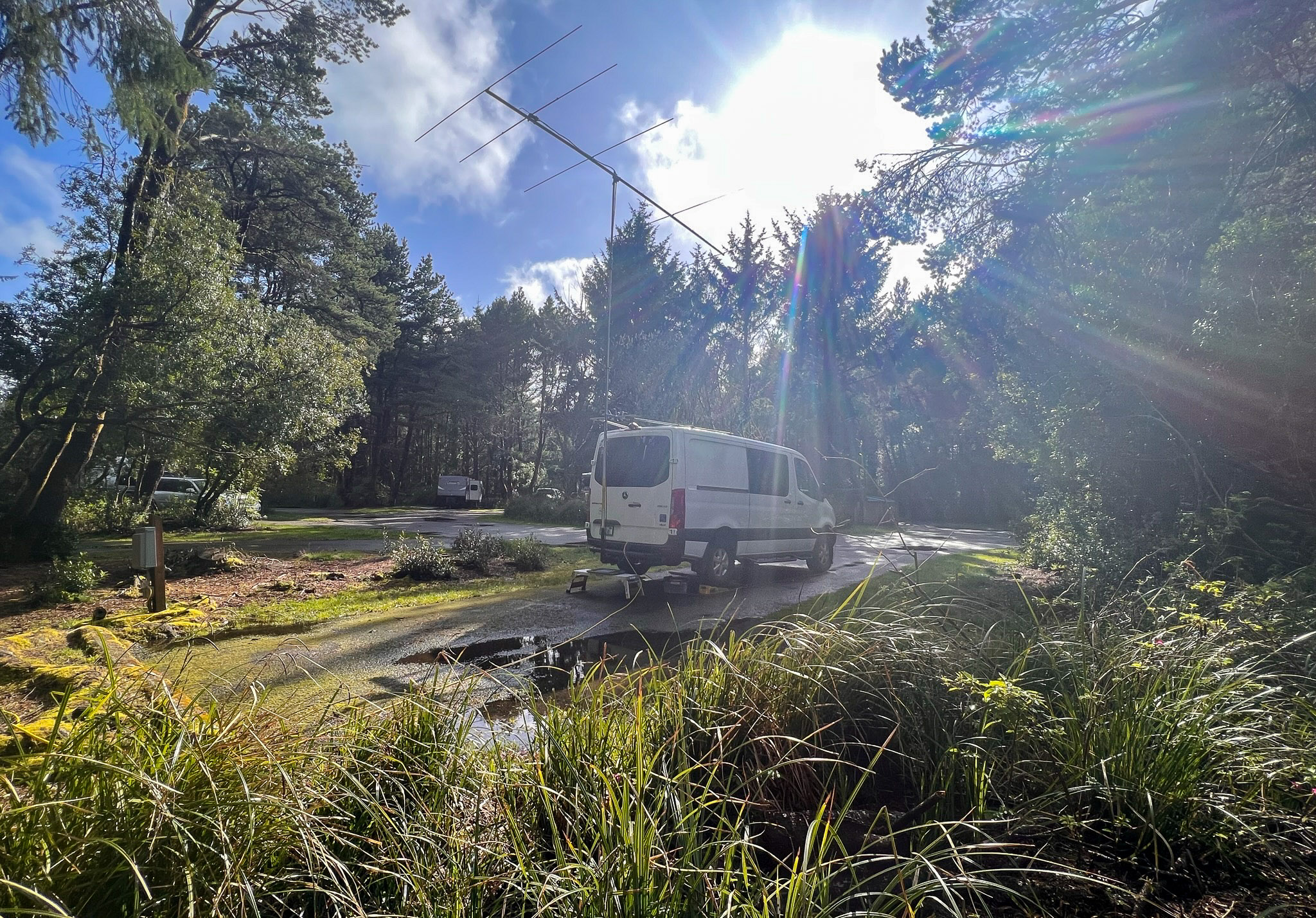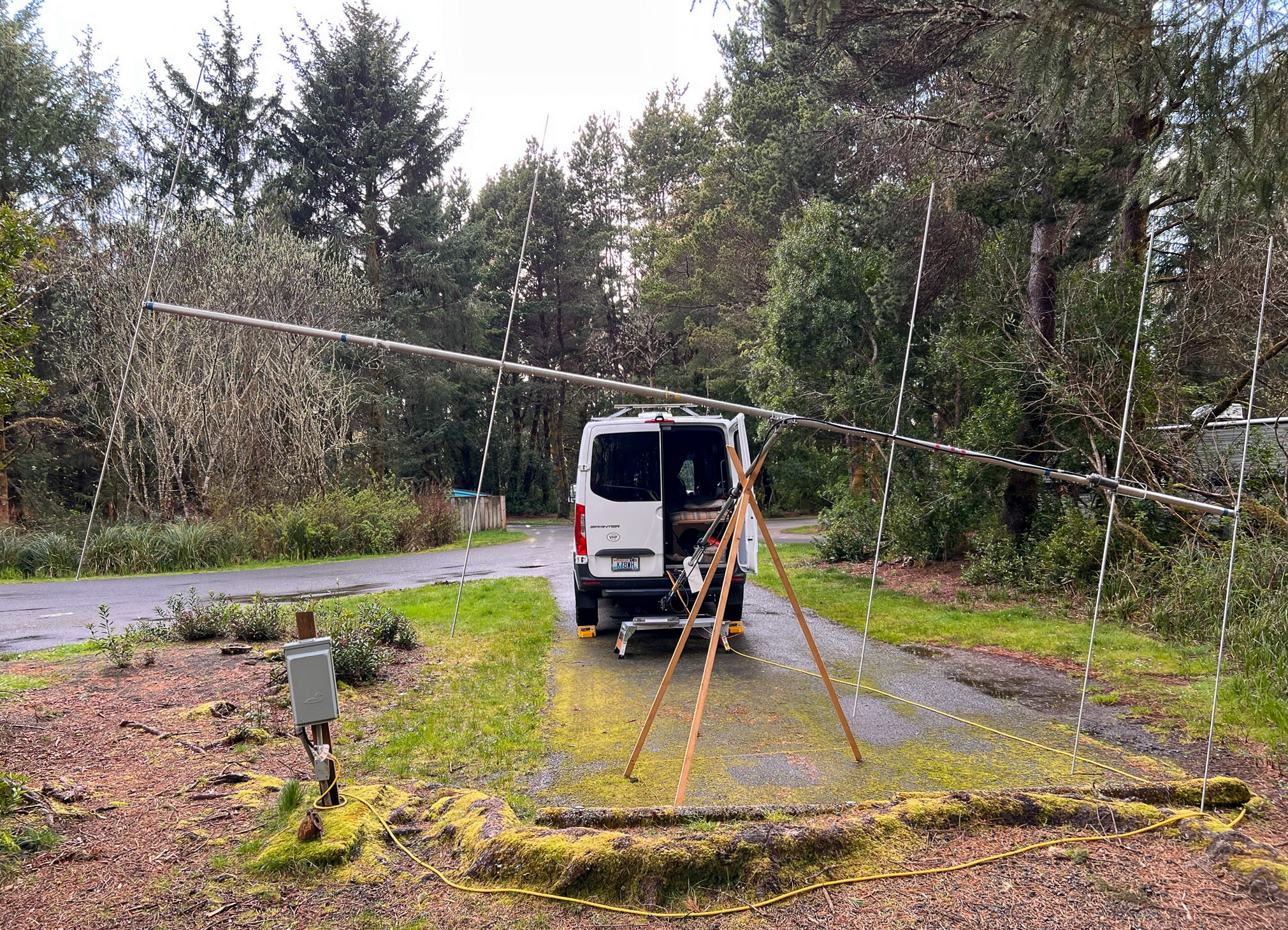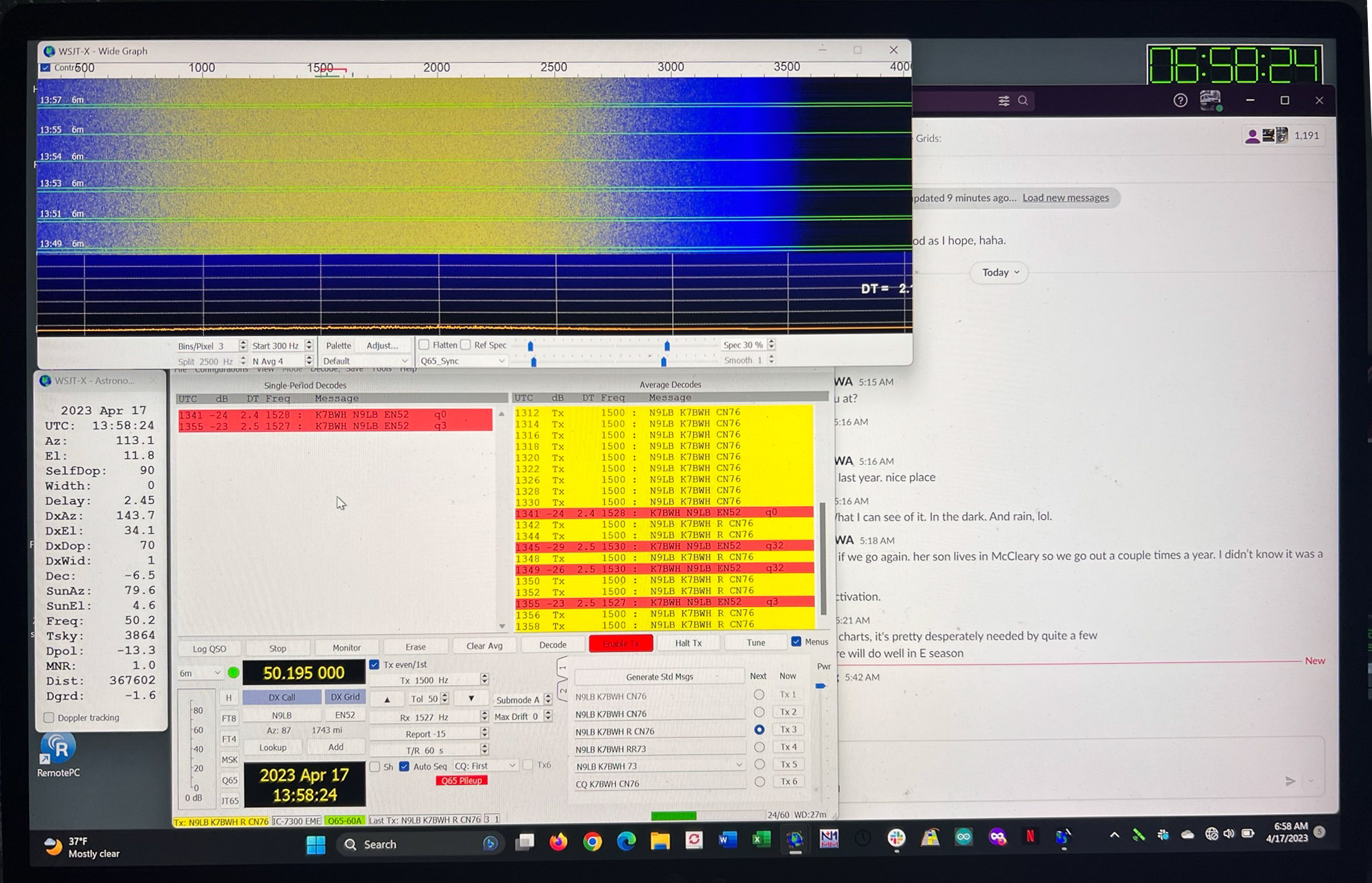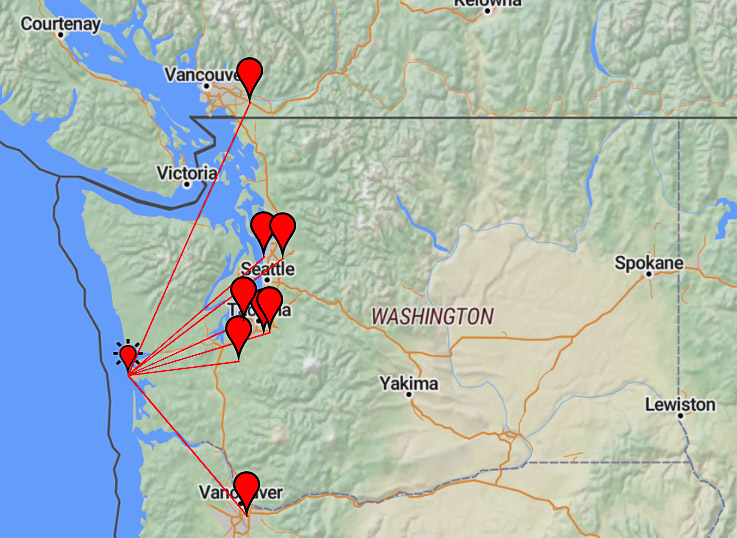
Rover Location Database
Travel
- Travel
- Apr '25 DN07
- Nov '24 DN19-29
- April '23 CN76
- Sept '22 CN76
- May '22 CN93
- Feb '22 CN93
- Jan VHF '22
- Dec '21 CN78
- Aug '21 CN76
- July '21 CN78
- May '21 Ely, NV
- July '20 CN98
- June '20 DN08
- June '20 N7G
- July '19 DN27-07
- Sept '18 CN98
- June '18 DN08
- June '18 DN22-43
- June '18 EN02
- June '18 Article
- June '18 EM87
- Summer '17
- Sept '16 CN87
- Apr '14 CN82-92
- Mar '14 Plan
- Jan VHF '14
- Jan '13
- Oct '12
- May '12
- Jan VHF '12
- Sept '11
- June '11
- May '11
- April '11 CN97
- March '11 CN97
CN76 for Lloyd N9LB
April 16-20, 2023
Here's my trip report from activating CN76 again to work Lloyd N9LB for his last FFMA grid.
April is very early in the season for E-skip. Don't ask me why I'm doing so many grid expeditions in bad conditions. I had hoped again that we might make up for terrestrial propagation by using EME. This was a learning experience and a bit humbling.
Weather? You've got to be kidding.
On my trip from Seattle, it was raining heavily in Aberdeen when I stopped for pizza. The rest of the trip was varying degrees of rain. How many pictures of rain do you need? These few should be enough.

And, once I reached the campground, the view out my window looked like this for four days. Don’t let my other photos mislead you – I only popped out to take photos during brief sun breaks.

K7BWH rover van reflected in a large rain puddle.

Twice I shut down the station and disconnected the coax during lightning storms. The Ventusky weather map shows the long trail of nearly endless rain on this trip. My location is marked in the lower right.

Grayland Beach State Park
Grayland Beach State Park is a beautiful place full of sand and moss and stunted coastal trees by an expansive sandy ocean beach. My campsite is only 10-20’ above sea level. The whole coastal area is dotted with sirens and "how to escape tsunami" direction signs.

Grayland Beach is within a stone’s throw of the temperate rain forests of the Olympic Peninsula. The 'rain forest' conditions were in very much in effect this week; this was one of the coldest Aprils on record and Spring weather has not turned sunny yet. I was surprised to find many, many acres of cranberry bogs and Cranberry Museum right across the highway.

The advantage of camping in a State Park is the creature comfort: parking on a level pad, plug-in to shore power (no generators this trip), clean convenient bathrooms, and more. The disadvantage is local RFI, at times very strong, which came and went.

I parked in campsite #49, chosen for its eastern location in the park. I didn’t want the antenna to point at other campers while trying to work Lloyd N9LB toward the east of here. Also, #49 was one of the very few campsites available during the exact time of the moon’s monthly low degradation.

It’s a popular state park and you should reserve a spot a month or more in advance, even during the off-season, if you want to have a choice.

Rover Van "Motel 5"
Thankfully, the shack kept me warm and dry during the frequent rain. Turning the mast was a short half-step out the back door. See my previous trip report for more photos of "Motel 5". Motto: Not nearly as swank and luxurious as Motel 6.


The M2 6m5 antenna is supported by a telescoping tilt-over mast. A simple scissor stand holds it up during assembly.


Station Improvements
I’ve made substantial improvements since my last trip to CN76 in September. At that time, Lloyd N9LB decoded my signals off the moon several times but I didn’t decode him at all. So, to improve my reception:
- Added a pre-amp and modified the IC-7300 to bring out a receive-only loop
- New shack DC electrical system, eliminating all inverters to lower my noise floor
- New coax cable
- 12v Victron charger to 12v bus (keeps 12v battery topped off)

- 48v Victron MultiPlus 3kva inverter/charger to 48v bus

- Two Eco-Worthy 48v 50Ah batteries

Although I acquired a 7el LFA antenna before this trip, it wasn’t ready yet for travel. I need to re-think my whole mast strategy for the much-bigger antenna.
Moonbounce
On our first morning, degradation was down to -1.6, when the moon was in a very quiet part of the sky. I got up at 4 am to run with Lloyd N9LB (and John W9JN on the phone) for two hours. My station decoded them seven times – my first EME decodes ever! Very exciting. However, they did not decode my signals at all. No contact.

The real problem was their station wasn’t decoding any Q65 signals, and really not much of any other digital mode signals. They shifted to local testing to frantically figure it out. Maybe it was a “contest mode” setting or maybe something else.
On our second morning, the moon’s degradation figure was still very good. I overslept my alarm by an hour and got up only 5 minutes before the 6 am moonrise. At 7, still no call from Lloyd or John. They must not be ready even though my moon was rising through 10 degrees (12 is optimum for my ground gain). I talked to Lloyd (on the phone!) and unfortunately John W9JN’s station had serious technical problems.
Finally, a big strong email with tears in its eyes came up to me and said his Harris amplifier has problems, a likely blown final transistor or broken relay. No moon shot will happen this trip.
However, there are other stations worldwide on the moon. So, in the evenings at my moon set, I arranged a contact with Tac JA7QVI in Japan. Although we made good attempts for two days, neither of us heard the other. I think the moon was too near the sun for our faint signals to be heard. In addition, the excellent 6m5 antenna is best at conventional propagation and its beam width (almost 45 degrees) is too wide for EME. Although friends have been telling me this all along, we must use what we’ve got until we can improve it.
After all these attempts, it goes to show that moonbounce is truly difficult. Everything must go perfectly. If one little thing is not quite right, no contact occurs.
Terrestrial
All my time, outside of moon rise and moon set, was spent on various WSJT modes to work as many people as possible. It ended up to be not a large number – no good openings occurred to the Pacific NW. The map from PSK Reporter made the Pacific NW look like the “No Fun Zone.”

My station improvements worked well. I could transmit at high power from batteries for at least 8 hours at a time. My signals were heard all around the nearest grids. I even worked John KM7O in Seattle with his 25w and 18’ of indoor wire.
In Slack chat, my station was jokingly called the "Voice of Washington State." At times, it seemed that was only as far as I could go.

Conclusion
Lloyd and I stayed by our radios for three days, waiting for some combination of path and WSJT mode to make a contact. No luck. There never was any E-skip to carry signals across the Rockies.
My best DX was 1,040 miles to K0GU in DN70mq, and 1,035 miles to N7EME in DM34sp.
Still, the trip was a lot of fun. My equipment worked well, the pre-amp proved itself valuable, the new 50v LiFePO4 batteries lasted all day and recharged overnight, and I made three dozen contacts. I gave rare grid CN76 to one person on the FFMA Leader Board, N7DED in CN88qk, a whopping 135 miles away. Good times.
I hope more local hams activate CN76 this summer so someone can work Lloyd N9LB. I might go myself again for the fourth time. Let the skip season begin!
- Barry K7BWH
| < Previous | Page 4 of 36 | Next > |
©1998-2025 Barry Hansen